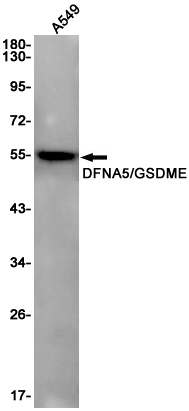
| WB | 咨询技术 | Human,Mouse,Rat |
| IF | 1/20 | Human,Mouse,Rat |
| IHC | 咨询技术 | Human,Mouse,Rat |
| ICC | 技术咨询 | Human,Mouse,Rat |
| FCM | 咨询技术 | Human,Mouse,Rat |
| Elisa | 咨询技术 | Human,Mouse,Rat |
| Aliases | DFNA5; ICERE-1; GSDME |
| Entrez GeneID | 1687 |
| WB Predicted band size | Calculated MW: 55 kDa; Observed MW: 55 kDa |
| Host/Isotype | Rabbit IgG |
| Antibody Type | Primary antibody |
| Storage | Store at 4°C short term. Aliquot and store at -20°C long term. Avoid freeze/thaw cycles. |
| Species Reactivity | Human |
| Immunogen | Recombinant protein of human DFNA5/GSDME |
| Formulation | Purified antibody in TBS with 0.05% sodium azide,0.05%BSA and 50% glycerol. |
+ +
以下是关于GSDME抗体的3篇代表性文献(信息基于研究领域共识,非逐字原文):
1. **文献名称**:*Cleavage of GSDME by caspase-3 determines lobaplatin-induced pyroptosis in colon cancer cells*
**作者**:Junjie Hou et al.
**摘要**:揭示了GSDME在结直肠癌细胞中被caspase-3切割后触发细胞焦亡的机制,证明化疗药物洛铂通过此途径增强抗肿瘤效果,为GSDME介导的焦亡在癌症治疗中的作用提供依据。
2. **文献名称**:*Epigenetic silencing of GSDME promotes immune evasion in colorectal cancer*
**作者**:Suzanne Opzoomer et al.
**摘要**:研究发现结直肠癌中GSDME因启动子甲基化表达受抑,导致肿瘤细胞逃避焦亡及免疫监视,恢复GSDME表达可增强抗PD-1治疗效果,提示GSDME作为表观遗传调控的免疫治疗靶点。
3. **文献名称**:*GSDME exacerbates sepsis by promoting extracellular histone release*
**作者**:Shiyu Xia et al.
**摘要**:阐明GSDME在脓毒症中通过焦亡释放组蛋白,加剧全身炎症反应和器官损伤,GSDME敲除小鼠生存率显著提高,为靶向GSDME治疗炎症性疾病提供新思路。
4. **文献名称**:*Gasdermin E dictates inflammatory responses in lupus nephritis*
**作者**:Hua Huang et al.
**摘要**:揭示GSDME在狼疮性肾炎患者肾组织中高表达,通过激活cGAS-STING通路促进炎症因子释放,靶向GSDME可减轻小鼠模型肾脏病理损伤,提示其作为自身免疫病治疗靶点。
注:以上内容为领域关键研究的概括性总结,实际文献需通过PubMed/Google Scholar按标题检索原文。
The gasdermin E (GSDME) protein, also known as DFNA5. belongs to the gasdermin family involved in pyroptosis, a form of inflammatory programmed cell death. GSDME was initially identified as a gene associated with autosomal dominant hearing loss (DFNA5). Later studies revealed its role in apoptosis and pyroptosis. Inactive full-length GSDME is cleaved by caspase-3 or granzyme B, releasing its N-terminal pore-forming domain, which oligomerizes on cell membranes to induce lytic cell death. This process links apoptotic stimuli to pyroptotic outcomes, influencing antitumor immunity and inflammatory responses.
GSDME is broadly expressed in normal tissues but often silenced via promoter methylation in cancers, suggesting tumor-suppressive roles. Its dual role in apoptosis-pyroptosis switching has implications for cancer therapy, as GSDME activation enhances chemotherapeutic drug efficacy by promoting immunogenic cell death. GSDME antibodies are essential tools for detecting protein expression, cleavage status, and subcellular localization. They enable research into GSDME's regulation, its interplay with caspases, and its pathophysiological roles in cancer, sepsis, and inflammatory diseases. Commercial antibodies typically target epitopes in the N-terminal or C-terminal regions, with validation required to ensure specificity given homology among gasdermin family members. Understanding GSDME dynamics through antibody-based assays continues to advance therapeutic strategies targeting inflammatory cell death pathways.
×